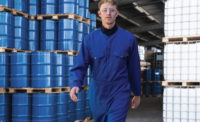Producing flame-resistant (FR) fabrics dates back to around 450 B.C. when textiles made from asbestos, which was known to have fire-resistant properties, were used to wrap the bodies of the deceased before they were placed on funeral pyres. Since these shrouds didn’t burn, they helped keep the ashes of the dead separate from the ashes of the fire.
In the centuries since, FR fabrics have taken a variety of forms, each with their own challenges. In 1821, Joseph Gay-Lussac discovered that treating fabrics with ammonium phosphates and borax made them somewhat fire retardant, but this treatment washed out of clothing too easily. During World War II, another flame-resistant finish was developed, but this one added significantly to the weight of the fabric. Other finishes, developed later, weakened the fabric instead.
Over time, techniques for developing FR fabrics significantly improved, resolving many of the issues seen with earlier solutions and even giving rise to fabrics that are inherently FR, rather than treated with an FR finish. But only recently has FR clothing evolved to a point where the fabrics are both effective and comfortable and the styles offer a look and fit that workers want to wear.
Comfort and style impact safety
It makes sense that comfort and style weren’t always top priorities in FR clothing — after all, the main focus was protection. But we now know that comfort and style can impact the safety benefits FR workwear provides.
If FR products are uncomfortable or unsightly, workers may be tempted to make alterations to them, or worse, skip wearing them altogether.
The more comfortable FR clothing is, and the more that FR styles align with modern preferences, the more likely it is that workers will wear the proper apparel and have the protection they need when they need it.
Improvements in comfort
In the past, FR clothing had a reputation for being heavy and stiff. But that is no longer the case.
One major change that contributes significantly to FR clothing comfort is fabric weight. FR protection can now be achieved with much lighter weight fabrics than ever before. These fabrics help make FR clothing more comfortable because they keep wearers cooler in warm temperatures and also tend to be easier to move around in.
FR fabric breathability has also improved over the years, helping to increase comfort. Breathable fabrics contribute to comfort by allowing air and moisture to easily pass through them, which helps to regulate temperature.
Another comfort-related fabric characteristic that has improved significantly since the early days of FR clothing is moisture management. When workers perspire, their clothing can become damp, causing it to grow heavy, change shape and stick to the skin — all of which cause discomfort. Many modern FR fabrics are designed to resolve this issue by wicking moisture away from the skin and drying quickly.
A final way FR clothing comfort has improved is through the development of multi-hazard protection. Products that combine FR properties with other safety benefits, such as chemical-splash protection (CP), offer a single protective garment for workplaces where previously two or more separate garments would often have been needed to address each hazard.
Better styles
Comfort isn’t the only thing that’s improved over the years. Today’s FR clothing offers significantly better style options as well.
In addition to classic coveralls, button down shirts and outerwear, you can now get henleys, knits and even base layer shirts that offer FR protection. And unlike early FR clothing, many of these styles now come in a broad selection of colors.
FR work pants have also evolved. Modern options include jeans made from soft, flexible fabrics and modeled after popular non-FR styles, as well as durable pants built with comfortable yet strong ripstop fabrics.
Women’s styles
One final, major improvement in FR clothing styles is the development of products designed specifically for women. Historically, FR clothing providers focused their efforts on men’s clothing, which meant that women who needed FR protection had to wear oversized, poor-fitting garments that compromised not only style, but also safety. But with increasing numbers of women working in industries such as utilities, oil and gas, and firefighting, manufacturers have begun developing better styles for women.
FR protection sure has come a long way since 450 B.C. That said, both comfort and style are largely subjective, and since preferences can vary significantly by workplace and individual, it is often beneficial to do a wear trial prior to purchasing FR workwear.






